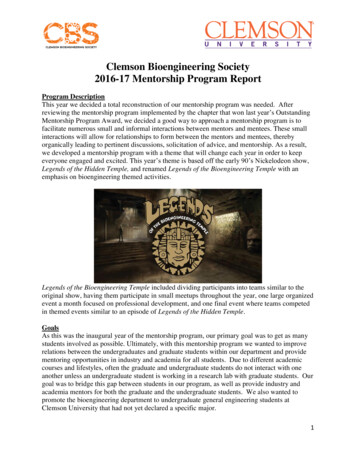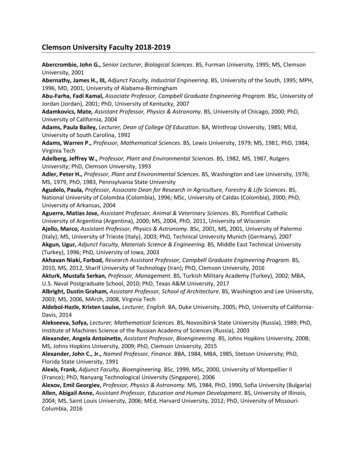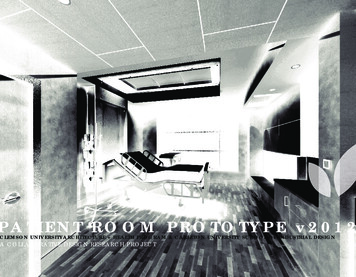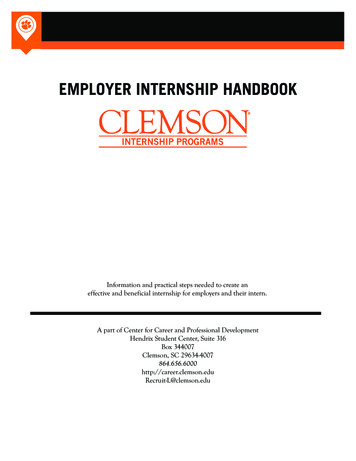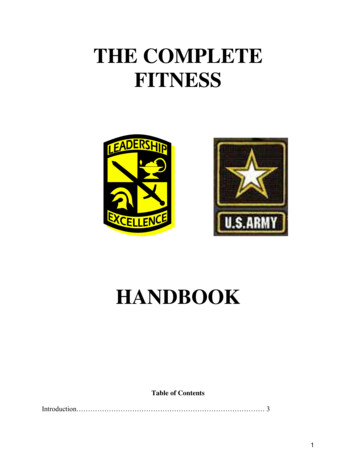
Transcription
THE COMPLETEFITNESSHANDBOOKTable of ContentsIntroduction 31
Physical Fitness . . 4Principals 4Fitness Assessment . . 5Fitness Questionnaire . . 6Diagnostic Test Scorecard .12Flexibility .13Program Description. 14The Road to Fitness .15Building your Strength Program/Tracking .17Get Stronger in 4 Weeks .19Prepare for Airborne School 21Prepare for NALC & Air Assault School . .23Cardiovascular Endurance .52Training Heart Rates . .52Interval Work Outs . 55Pace Chart . 612
IntroductionCadet Command would like to thank the Dr. Todd A. Crowder from the United StatesMilitary Academy (USMA) Department of Physical Education for his work in assisting us in thisproject. He graciously allowed us to edit his work on cardio-respiratory training in order totailor it towards ROTC cadets who have varying fitness needs at over 270 schools. CadetCommand would not have been successful in writing this Fitness Handbook without his help andthe help of other fitness experts at the USMA and from the United States Army Physical FitnessSchool.Before You BeginIt is imperative that cadets learn an easy way to reduce the likelihood of injury whileusing this Fitness Handbook. Cadets need to recognize that they have an increased risk of lowerbody injuries than upper body injuries during summer training events. The leading causes of thisare improperly sized or poorly broken-in boots and inadequate running shoes. Boots that hurt oruncomfortable to you at school will cause significantly more discomfort and increase the chanceof injury during rigorous summer training events like the National Advanced Leadership Camp,Airborne School or Air Assault School. A broken in pair of boots should feel as comfortable asyour most comfortable pair of shoes. To put it simply, you should be able to walk or run in themcomfortably.Similarly running shoes should fit comfortably and not show significant tread wear.Running places different wear on your shoes than walking does. Using shoes you walk in forrunning can place undo stress on your lower body. This stress can increase the risk of injury.Field Manual 21-20 divides running shoes into three categories. Select an impact control shoe ifyou have high arches or notice that your running shoes tend to wear unevenly on the outsideedge. Select a motion control shoe if you have flat feet or notice that excessive wear on both theextreme outside and inside of the sole of the running shoe. Select a balanced shoe if you havenormal arches or only see wear on the outside sole beneath the ankle.Other factors that reduce the likelihood of injuries include adequate warm-ups prior tohigh intensity exercise, proper nutrition and hydration, maintaining recovery periods followingexercise, and cool-down periods concluding the exercise.Editors Ms. Sheila ViscontiMajor Paul BakerCPT Ellis Goins3
Physical FitnessTRAINING VARIABLESBefore explaining what a physical fitness program should look like, there are some basicterms that must be discussed. These principals apply to all programs in general and must beaddressed in the development of any fitness program.INTENSITY – The amount of effort put into each workout, usually measured byheartbeats per minute. For the maximum benefit in each workout, plan on exercising at aminimum of 70 percent of the heart rate reserve. There are several scientific ways to your heartrate reserve. The simplest way is to begin with you maximum heart rate (220-Age). Next,measure your resting heart rate. The heart rate reserve is found by Max heart rate - resting heartrate. To train at 70% of the heart rate reserve you would multiply 70% by the heart rate reserveand then add your resting heart rate. For a 20 year old with a resting heart rate of 60 todDetermineing your training heart rate in beats per minute would be 70% x Heart Rate Reserve .70 x (200-60) 60 (Resting Heart Rate) a training heart rate of 158 beats per min.DURATION – The length each exercise period should last. There has been a great deal ofresearch on this topic. Most experts believe that when working on your cardiovascular endurancea minimum of 20 to 30 minutes is needed to obtain maximum benefit. This holds true for themajority of the population. The only notable exception occurs for long distance or enduranceathletes (e.g. marathon runners or triathletes).FREQUENCY – The number of workouts one should have per week. Once again expertsagree that the average person requires a minimum of three workouts per week to improve theircurrent level of fitness. Working out less frequently will only maintain a level of fitness; it willnot improve the level of fitness. When exercising only three times a week, each period should bemedium to high intensity. Exercising with consistent frequency can also be referred to asREGULARITY. Exercise must be done regularly to produce a training effect. Sporadic exercisemay cause more harm in the form of injury than benefit from exercise. The same is true forextremely intense workouts. They may create injuries.RECOVERY – Do not work the same muscle groups hard day after day. Musclesneed recovery time. People frequently misunderstand this point. Providing inadequate recoverycan explain the reason why most people see little or no gain from excessive exercise. You canwork the same muscle groups each day, however, you should work hard one day and easy thenext. This is a critical point because this fitness program is based on a six days a week exerciseprogram.GENERAL ADAPTATION PRINCIPAL (GAP) – Muscles as well as yourcardiovascular system in the body will adapt to the increasing stress placed upon it throughexercise. To see gains in a fitness program one must stress the existing muscular andcardiovascular systems. This can also be called the OVERLOAD principal. For a muscle toincrease in strength, the workload during exercise must be larger than what it normallyexperiences.4
SPECIFICITY – There are several different exercises and events that can develop yourmuscular strength as well as cardiovascular fitness. To increase the number of push-ups you cando, simply increase upper body strength through a number of strength exercises and weights.However, the best way to improve push-ups requires doing push-ups. Similarly one can improvecardiovascular fitness by biking swimming, or walking. However, if the goal remains animproved ability to run, the best exercise will be running.MAJOR COMPONENTS OF PHYSICAL FITNESS – There are several components ofany fitness program. The three major components of most programs are flexibility, strength,muscular endurance, and cardiovascular endurance. These components are the essentialelements of the Army Physical Fitness Program.How to Use These Workout ProgramsThese programs are designed as four week plans. Each program has a workout A & B.Alternate workouts daily for 6 days, then rest. For example, perform workout A on Monday,Wednesday, and Friday; perform workout B on Tuesday, Thursday, and Saturday. Differentmuscles are trained in workouts A & B, which means you are training each muscle group 3 daysper week. Rest Sunday. Work cardiovascular exercises into your workouts at least 3 times perweek. You may attempt to eventually work up to doing cardio 6 days a week using the hard/easytechnique mentioned under the recovery principle.Fitness AssessmentBefore starting any new fitness program it is important to assess ones abilities. Thisincludes knowing strengths as well as weaknesses. Ideally, a fitness program would improveweak areas and maintain or improve strength areas. However, before explaining the diagnostictest there are other important factors and preferences that should be identified. These factors andpreferences may include the time of day to workout, how much time is available each day toworkout, individual or team sports, and finally the goal of the fitness program.The questionnaire attached (FORM 1-1) is intended to give a fitness trainer the basicsthey need to personalize a fitness program that will works.5
Fitness Assessment QuestionnaireNAME AGE DATEACADEMIC SCHEDULE: Monday(this RCISE HABITS/ PREFERENCES (Select One)I to exercise and access to a gym(like, sometimes like, never want )(have, do not have)I like to workout(alone, in a small group, in a large group)I have discipline to stick to a fitness program( a little, some, a lot of)I need to stick to my fitness program(no help, some help, a lot of help)I to lift weights(like, have tried, have never tried)I prefer to for my cardiovascular endurance training(run, walk, bike, swim, skate)GOALSI want to:A. Improve my overall personal fitnessB. Just pass the APFTC. Just improve a particular weaknessSTATE YOUR PERSONAL GOALSSELF ASSESSMENT (Select: None, Beginner, Average, Above Average, Excellent)FlexibilityStrengthCardiovascular EnduranceList your weaknessList your strengthsWork Form 1-16
Diagnostic TestThe purpose of the diagnostic test is to assess one’s level of flexibility, strength andcardiovascular endurance. This diagnostic test is composed of 6 events. The six events are asfollows and will be performed in order. A brief warm-up period will precede the administrationof the test. The warm up should consist of a combination of stretching exercises and jogging inplace for 3 to 5 minutes. The warm-up may consists of jogging in place for 3 minutes, startingslowly and increasing intensity to warm the body’s muscles and ligaments. Light stretchingshould follow the warm-up.1. First event: Bench Press. Cadets will perform a 1-rep maximum of this exercise todetermine chest, shoulders, and triceps strength. A cadet should begin with a weight which theyare confident they can press. Allow at least 1 minute rest between attempts. The weight will beincreased at the cadet’s request and he will perform the exercise again. Allow no more than 5attempts to reach the 1-rep maximum. Any failed attempt terminates the exercise. The lastcorrect repetition will count as the 1-rep maximum.Figure 1(1) Equipment. Flat weight bench. At least 1, preferably 2 spotters. Lifting gloves areauthorized. Bench press shirts are not authorized. (2) Performance. Lie in a supine position ona flat bench with your legs positioned at the sides of the bench and your feet flat on the floor.Using a handgrip that is about 6 inches wider than your shoulder width, bring the barbell to armslength above the chest but in line with the shoulders (see fig 1). If two spotters are available theywill position themselves on each side of the bar. The spotters may assist in the liftoff. If onlyone spotter is available, he/she will be at the lifter’s head to assist. Once the bar is at the startposition the spotter will release the bar. Lower the barbell to the chest and make a definitepause. As soon as momentum has ceased the grader will yell press. Press the barbell to the startposition to complete the repetition. The spotter will not touch the barbell during the repetition7
unless absolutely necessary. If the spotter has to assist the lifter during the repetition the event isterminated.Upper Body Strength 1 rep max in pounds divided by body weight in pounds54321Malesgreater than 1.261.17 - 1.25.97 - 1.16.88 - .96less than .8754321Femalesgreater than .78.72 - .77.59 - .71.53 - .58less than .522. Second Event: Push-up. Cadets will perform as many push-ups as they can todetermine the muscular endurance of the chest shoulder, and triceps muscles.(1) Equipment. Flat area.(2) Performance. On the command 'get set,' assume the front-leaning rest position byplacing your hands where they are comfortable for you. Your feet may be together or up to 12inches apart. When viewed from the side, your body should form a generally straight line fromyour shoulders to your ankles. On the command 'go,' begin the push-up by bending your elbowsand lowering your entire body as a single unit until your upper arms are at least parallel to theground. Then, return to the starting position by raising your entire body until your arms are fullyextended. Your body must remain rigid in a generally straight line and move as a unit whileperforming each repetition. At the end of each repetition, the scorer will state the number ofrepetitions you have completed correctly. If you fail to keep your body generally straight, tolower your whole body until your upper arms are at least parallel to the ground, or to extend yourarms completely, that repetition will not count, and the scorer will repeat the number of the lastcorrectly performed repetition. An altered, front-leaning rest position is the only authorized restposition. That is, you may sag in the middle or flex your back. When flexing your back, you maybend your knees, but not to such an extent that you are supporting most of your body weight withyour legs. If this occurs, your performance will be terminated. You must return to, and pause in,the correct starting position before continuing. If you rest on the ground or raise either hand orfoot from the ground, your performance will be terminated. You may reposition your handsand/or feet during the event as long as they remain in contact with the ground at all times.Correct performance is important. You will do as many push-ups as you can; there is no timelimit.3. Third Event: Curl-up. Cadets will perform the curl-up exercise to assess abdominalstrength and endurance.(1) Equipment. Mat, Ruler, metronome, stop watch(2) Performance. Start with your back on the
Work cardiovascular exercises into your workouts at least 3 times per week. You may attempt to eventually work up to doing cardio 6 days a week using the hard/easy technique mentioned under the recovery principle. Fitness Assessment Before starting any new fitness program it is important to assess ones abilities. This includes knowing strengths as well as weaknesses. Ideally, a fitness program .





